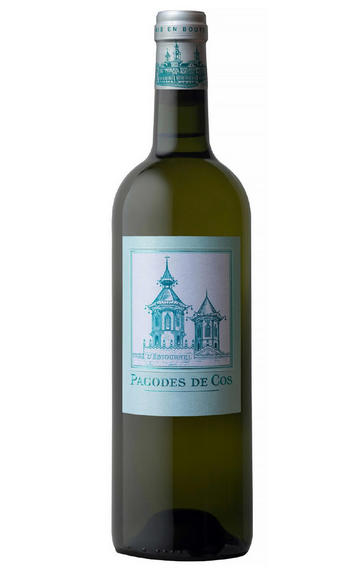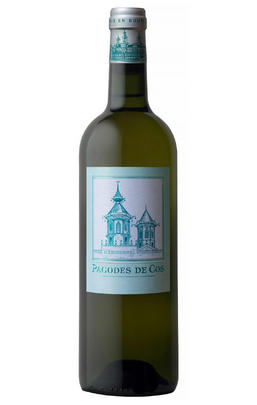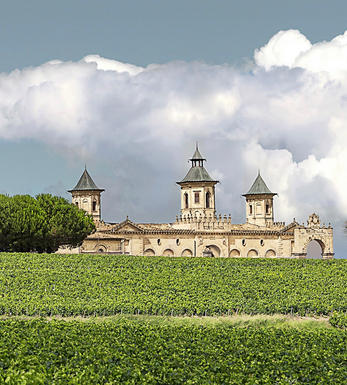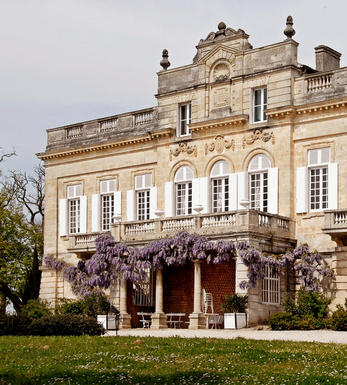
2021 Pagodes de Cos Blanc, Bordeaux

Critics reviews
The 2021 Pagodes de Cos Blanc has a fresh nose driven by the Sauvignon Blanc, slightly smoky in style. The palate is well balanced, fresh and saline, offering green apple, kumquat and a touch of lemongrass and a vibrant finish. Enjoy this over the next decade.
Drink 2024 - 2033
Neal Martin, Vinous.com (May 2022)
Slight reduction on the first nose, juicy white pear, fresh acidities, touches of slate. 42hl/h yield, 55% 1st wine. Harvest September 17 though to October 9, longest on record, finishing up with the Sémillon after all red grapes.
Drink 2022 - 2028
Jane Anson, JaneAnson.com (May 2022)
Offering up aromas of gooseberry, pear, lemon curd and pastry cream, the 2021 Pagodes de Cos Blanc is medium to full-bodied, layered and fleshy, with a satiny attack that segues into a chalky mid-palate animated by tangy acids.
Drink 2024 - 2035
William Kelley, Wine Advocate (February 2024)
85% Sauvignon Blanc and 15% Sémillon.
Intense, with plenty of flint, dried herbs, dried lemons, guava and a smoky touch. Medium-to full-bodied with bright acidity. Concentrated, yet vivid and energetic. Tangy. So delicious.
James Suckling, JamesSuckling.com (May 2022)
About this WINE

Cos d'Estournel
Château Cos d`Estournel is named after its 19th century owner, Louis-Gaspard d'Estournel, and it was he who built the bizarre oriental edifice that is a landmark for any tourist in the Médoc. Today Cos d'Estournel is without doubt the leading estate in St-Estéphe. It is located in the south of the appellation on the border with Pauillac and its vineyards are superbly sited on a south-facing gravel ridge with a high clay content, just north of Lafite.
Cos d'Estournel is typically a blend of 60% Cabernet Sauvignon, 38% Merlot and 2% Cabernet Franc - do not be fooled by the relatively high Merlot content, as these are full-bodied, dark, brooding tannic wines when young which develop a complexity and intensity that can rival many top growths from Pauillac.
In 1998 the Prats family sold Cos d'Estournel to The Tailan Group. Cos d'Estournel is classified as a 2ème Cru Classé.

Saint-Estèphe
Saint-Estèphe is the northernmost of the most important communes of the Médoc and borders Pauillac on its southernmost border, with only a gully and stream separates it from Ch. Lafite. To the north lies the Bas-Médoc.
Saint-Estèphe is defined by the depth of its gravel, which is ubiquitous but of varying depths and occasionally very shallow, when clay predominates. This keeps the soil cooler and wetter than its counterparts so that the wines can appear fresh in lighter vintages, but superbly successful in hot, dry years.
The best châteaux in the south of the commune have the deepest soil and the thickest gravel. Cos d'Estournel has an exceptional terroir with its vineyards being located on a south-facing ridge of gravel with excellent drainage.
Saint-Estèphe is the least gravelly of main Médoc communes and in the north of the commune the vineyards are heavier and more clay-based leading to a rustic style of wine being produced.
The wines can appear austere in youth with a discernable ferric note at some châteaux, but the best typically display good depth of colour, pronounced acidity an tannins in youth and are exceptionally long-lived. At their best, they are the equal of almost any Bordeaux. The well-regarded St Estèphe co-operative controls the production of about half the appellation.
Recommended Châteaux
Cos (Ch. Cos d'Estournel), Ch. Montrose, Ch. Calon-Ségur, Ch. Lafon-Rochet, Ch. Les Ormes de Pez, Ch. Beau-Site, Ch. Cos Labory, Ch. Phélan-Ségur

Cabernet Sauvignon Blend
Cabernet Sauvignon lends itself particularly well in blends with Merlot. This is actually the archetypal Bordeaux blend, though in different proportions in the sub-regions and sometimes topped up with Cabernet Franc, Malbec, and Petit Verdot.
In the Médoc and Graves the percentage of Cabernet Sauvignon in the blend can range from 95% (Mouton-Rothschild) to as low as 40%. It is particularly suited to the dry, warm, free- draining, gravel-rich soils and is responsible for the redolent cassis characteristics as well as the depth of colour, tannic structure and pronounced acidity of Médoc wines. However 100% Cabernet Sauvignon wines can be slightly hollow-tasting in the middle palate and Merlot with its generous, fleshy fruit flavours acts as a perfect foil by filling in this cavity.
In St-Emilion and Pomerol, the blends are Merlot dominated as Cabernet Sauvignon can struggle to ripen there - when it is included, it adds structure and body to the wine. Sassicaia is the most famous Bordeaux blend in Italy and has spawned many imitations, whereby the blend is now firmly established in the New World and particularly in California and Australia.


Buying options
Add to wishlist
Description
Sauvignon Blanc 85%, Sémillon 15%.
This is produced in small volumes. It comes from vines in the Port de Goulée in the northern Médoc, by the mouth of the Gironde Estuary. Some vines are as old as 37. This Sauvignon-dominated blend has a tropical nose, with ripe apricots, mangoes, gooseberries and a hint of ginger spice. The palate is rich and juicy but balanced by a fresh burst of acidity and a saline finish.
Drink 2023 - 2038
Our score: 16/20
Berry Bros. & Rudd
wine at a glance
Delivery and quality guarantee